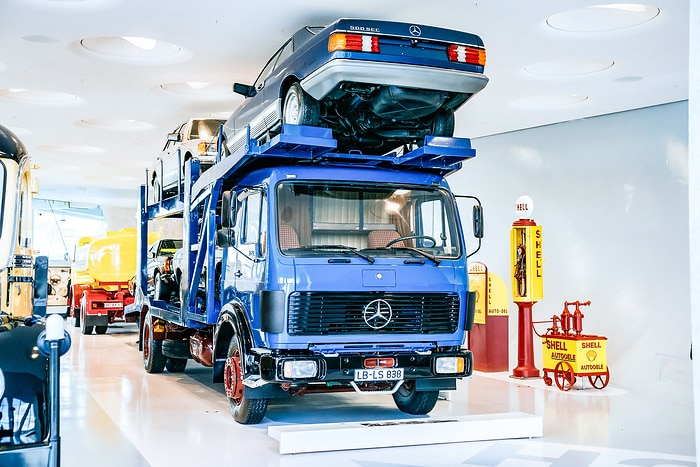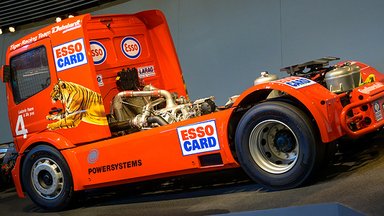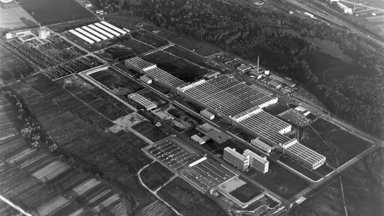
A giant aloft: The car transporter at the Mercedes-Benz Museum
Download

A giant aloft: The car transporter at the Mercedes-Benz Museum
The lorry weighing several tonnes is on show five floors up from the street The Museum’s building construction and logistics systems make this possible Mercedes-Benz saloons and coupés as cargo Stuttgart. “Close-up” – the name of this series from the Mercedes-Benz Museum says it all. Each instalment tells a surprising, exciting or behind-the-scenes story, illuminating details of a vehicle, an exhibit or an architectural or…
- The lorry weighing several tonnes is on show five floors up from the street
- The Museum’s building construction and logistics systems make this possible
- Mercedes-Benz saloons and coupés as cargo
Stuttgart. “Close-up” – the name of this series from the Mercedes-Benz Museum says it all. Each instalment tells a surprising, exciting or behind-the-scenes story, illuminating details of a vehicle, an exhibit or an architectural or design feature. In the spotlight this time: the Mercedes-Benz car transporter in the Collection Room 2: Gallery of Carriers.
No. 3/2024: Mercedes-Benz 1624 car transporter
Larger than life: The car transporter at the Mercedes-Benz Museum fascinates many visitors simply because of its size. How can such a large and heavy vehicle be brought into position in the light-flooded space five floors above street level? This is made possible by the construction of the Mercedes-Benz Museum and the integrated logistics.
Load-bearing concrete and lifts: Commercial vehicles are an integral part of the Museum concept. Accordingly, the building is designed to take their weight. Especially the Collection rooms: their floors and walls can bear heavy loads weighing many tonnes. Then there are the logistics: a large door can be seen on the inside wall. This leads to the atrium via a connecting passageway. The heavy-duty lift installed there served to raise the car transporter to lofty heights and then roll it through the door to its allocated space. This was all well within the capabilities of the crane system, which is able to carry up to 40 tonnes. The payload of the suspended crane basket is 20 tonnes. The empty car transporter weighs around 7 tonnes. The commercial vehicle was not loaded until it had been parked in the exhibition area.
Vehicle fleet on board: In total, the exhibit consists of five vehicles. In addition to the car transporter itself, there are four Mercedes-Benz passenger cars. This load weighs in at around 6 tonnes. If the trailer were hitched as well, the transporter could even carry up to ten cars in total. Its capacity and flexibility make the blue commercial vehicle an efficient logistics professional.
The last of their kind: The car transporter has two genuine milestones on board, in the guise of a Mercedes-Benz 230 E and a 280 CE from the 123 model series. These are the final saloon and coupé models respectively from this generation of the Mercedes-Benz upper mid-range to run off the production line. Such vehicles from the end of a production series generally embody customers typical preferences in a given era. As such, they represent key milestones in the company’s vehicle collection. Mercedes-Benz Classic refers to such end-of-production vehicles when planning the supply of spare parts, for example. The car transporter also has a 380 SEL and a 500 SEC from the 126 series on board, as well as a saloon and coupé respectively. Both are part of the S-Class tradition.
A true all-rounder: The Mercedes-Benz 1624 car transporter itself belongs to the so-called “New Generation” of heavy- and medium-duty lorries (NG). This generation was built from 1973 to 1988. The transporter’s diesel engine has a displacement of 12.8 litres and generates 177 kW (240 hp) of power. This makes the 1624 suitable for many logistics tasks, and it is ordered ex works in a wide range of different versions. Today, the Mercedes-Benz Actros and Atego are available for long-distance and distribution transport.
Heavy metal ballet: The body of a car transporter with its vertical uprights, cross struts and loading platforms appears highly stable. But it is by no means immobile. Individual elements of the loading platforms can be raised, lowered and tilted. This is necessary for loading vehicles of different sizes on two levels. In today’s car transporters, numerous hydraulic elements perform these movements, which look like mechanical ballet to an experienced operator. The Museum exhibit has a hybrid drive: the power is generated by a central hydraulic system, and steel cables transfer this to the required points via guide pulleys and pulley blocks.
Delivering dreams: The four passenger cars on the car transporter in the Museum are now popular classics. To this day, a personal dream car from Mercedes-Benz usually begins its journey through life on a car transporter. A large proportion of the passenger cars built at the Mercedes-Benz plant in Sindelfingen, for example, leave on such commercial vehicles. This is how they reach branches and dealers – and then the customer.
Article assets

A giant aloft: The car transporter at the Mercedes-Benz Museum

A giant aloft: The car transporter at the Mercedes-Benz Museum

A giant aloft: The car transporter at the Mercedes-Benz Museum

A giant aloft: The car transporter at the Mercedes-Benz Museum

A giant aloft: The car transporter at the Mercedes-Benz Museum

A giant aloft: The car transporter at the Mercedes-Benz Museum

A giant aloft: The car transporter at the Mercedes-Benz Museum

Ulrike Burkhart
Spokesperson Mercedes Benz Trucks Product, Service & eTruck
ulrike.burkhart@daimlertruck.com
+49 160 861 3757

Carola Pfeifle
Spokesperson Product Communications Mercedes-Benz Trucks
carola.pfeifle@daimlertruck.com
+49 160 8612423








